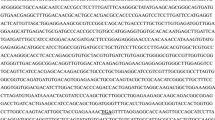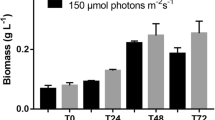Abstract
Haematococcus pluvialis is a green alga known to accumulate the keto-carotenoid astaxanthin under stress conditions. In H. pluvialis, carotenoids are derived from isopentenyl diphosphate (IPP), which is synthesized via the non-mevalonate methyl-d-erythritol 4-phosphate (MEP) pathway. The present study revealed that several treatments caused changes in pigment profiles and the expression levels of genes encoding MEP pathway enzymes. Additionally, photosynthesis fluorescence was monitored. Generally, under stress conditions, there was an increase in astaxanthin, along with a decrease in total chlorophyll and photo capacity. Six IPP biosynthetic genes were cloned from H. pluvialis. Expression analysis revealed that these transcripts were upregulated under stress culture conditions. However, the extent of MEP pathway gene expression varied with the stress conditions. 4-Diphosphocytidyl-2-C-methyl-d-erythritol (CDP-ME) synthase (CMS) and CDP-ME kinase (CMK) exhibited significantly higher transcriptional expression under nitrogen starvation treatments. While 1-deoxy-d-xylulose 5-phosphate (DXP) synthase (DXS), CMS, CMK 1-hydroxy-2-methyl-2-(E)-butenyl 4-diphosphate (HMBPP) synthase (HDS), and HMBPP reductoisomerase (HDR) showed significant upregulation on the second day under nitrogen starvation and high light (HL-N). The enhanced expression of these genes was also observed on the third day under high light. The high expression of MEP pathway genes was correlated with the accumulation of astaxanthin under HL-N stress. This is the first report of the isolation of IPP biosynthetic genes and their differential expression in H. pluvialis under stress conditions. The present study revealed the influence of stress conditions on the expression of MEP pathway genes and changes in pigment profiles.







Similar content being viewed by others
References
Alcaíno J, Romero I, Niklitschek M, Sepúlveda D, Rojas MC, Baeza M, Cifuentes V (2014) Functional characterization of the Xanthophyllomyces dendrorhous farnesyl pyrophosphate synthase and geranylgeranyl pyrophosphate synthase encoding genes that are involved in the synthesis of isoprenoid precursors. PLoS One 9(5), e96626
Borowitzka MA (2010) Carotenoid production using microorganisms. In: Cohen Z, Ratledge C (eds) Single cell oils. Microbial and Algal Oils. AOCS Press, Urbana, pp 225–240
Botella-Pavía P, Besumbes Ó, Phillips MA, Carretero-Paulet L, Boronat A, Rodríguez-Concepción M (2004) Regulation of carotenoid biosynthesis in plants: evidence for a key role of hydroxymethylbutenyl diphosphate reductase in controlling the supply of plastidial isoprenoid precursors. Plant J 40:188–199
Boussiba S, Vonshak A (1991) Astaxanthin accumulation in the green alga Haematococcus pluvialis. Plant Cell Physiol 32:1077–1082
Carretero-Paulet L, Cairó A, Botella-Pavía P, Besumbes O, Campos N, Boronat A, Rodríguez-Concepción M (2006) Enhanced flux through the methylerythritol 4-phosphate pathway in Arabidopsis plants overexpressing deoxyxylulose 5-phosphate reductoisomerase. Plant Mol Biol 62:683–695
Estévez JM, Cantero A, Reindl A, Reichler S, León P (2001) 1-Deoxy-D-xylulose-5-phosphate synthase, a limiting enzyme for plastidic isoprenoid biosynthesis in plants. J Biol Chem 276:22901–22909
Fan L, Vonshak A, Zarka A, Boussiba S (1998) Does astaxanthin protect Haematococcus against light damage? Z Naturforsch C 53:93–100
Gao ZQ, Meng CX, Ye NH (2012) Differential expression of carotenogenic genes, associated changes on astaxanthin production and photosynthesis features induced by JA in H. pluvialis. Plos One 7(8):e42243
Gao Z, Meng C, Gao H, Zhang X, Xu D, Su Y, Wang Y, Zhao Y, Ye N (2013) Analysis of mRNA expression profiles of carotenogenesis and astaxanthin production of Haematococcus pluvialis under exogenous 2, 4-epibrassinolide (EBR). Biol Res 46:201–206
Giuliano G, Bartley GE, Scolnik PA (1993) Regulation of carotenoid biosynthesis during tomato development. Plant Cell 5:379–387
Gong YF, Liao ZH, Guo BH, Sun XF, Tang KX (2006) Molecular cloning and expression profile analysis of Ginkgo biloba DXS gene encoding 1-deoxy-D-xylulose 5-phosphate synthase, the first committed enzyme of the 2-C-methyl-D-erythritol 4-phosphate pathway. Planta Med 72:329–335
Grünewald K, Eckert M, Hirschberg J, Hagen C (2000) Phytoene desaturase is localized exclusively in the chloroplast and up-regulated at the mRNA level during accumulation of secondary carotenoids in Haematococcus pluvialis (Volvocales, Chlorophyceae). Plant Physiol 122:1261–1268
Gwak Y, Hwang Y, Wang B, Kim M, Jeong J, Lee CG, Hu Q, Han D, Jin ES (2014) Comparative analyses of lipidomes and transcriptomes reveal a concerted action of multiple defensive systems against photooxidative stress in Haematococcus pluvialis. J Exp Bot 65:4317–4334
Hans J, Hause B, Strack D, Walter MH (2004) Cloning, characterization, and immunolocalization of a mycorrhiza-inducible 1-deoxy-d-xylulose 5-phosphate reductoisomerase in arbuscule-containing cells of maize. Plant Physiol 134:614–624
Huang JC, Chen F, Sandmann G (2006) Stress-related differential expression of multiple β-carotene ketolase genes in the unicellular green alga Haematococcus pluvialis. J Biotechnol 122:176–185
Kim SM, Kim SU (2010) Characterization of 1-hydroxy-2-methyl-2-(E)-butenyl-4-diphosphate synthase (HDS) gene from Ginkgo biloba. Mol Biol Rep 37:973–979
Lange BM, Wildung MR, McCaskill D, Croteau R (1998) A family of transketolases that directs isoprenoid biosynthesis via a mevalonate-independent pathway. Proc Natl Acad Sci U S A 95:2100–2104
Lemoine Y, Schoefs B (2010) Secondary ketocarotenoid astaxanthin biosynthesis in algae: a multifunctional response to stress. Photosynth Res 106:155–177
Li YT, Sommerfeld M, Chen F, Hu Q (2010) Effect of photon flux densities on regulation of carotenogenesis and cell viability of Haematococcus pluvialis (Chlorophyceae). J Appl Phycol 22:253–263
Liu W, Chen M, Yang C, Yang Y, Lan X, Liao Z (2009) A new 2-C-methyl-D-erythritol 2,4-cyclodiphosphate synthase gene from Taxus media: cloning, characterization and functional complementation. J Med Plant Res 3:395–402
Livak KJ, Schmittgen TD (2001) Analysis of relative gene expression data using real-time quantitative PCR and the 2-ΔΔC T method. Methods 25:402–408
Lois LM, Rodríguez-Concepción M, Gallego F, Campos N, Boronat A (2000) Carotenoid biosynthesis during tomato fruit development: regulatory role of 1-deoxy-D-xylulose 5-phosphate synthase. Plant J 22:503–513
Mahmoud SS, Croteau RB (2001) Metabolic engineering of essential oil yield and composition in mint by altering expression of deoxyxylulose phosphate reductoisomerase and menthofuran synthase. Proc Natl Acad Sci U S A 98:8915–8920
Mannen K, Matsumoto T, Takahashi S, Yamaguchi Y, Tsukagoshi M, Sano R, Suzuki H, Sakurai N, Shibat D, Koyama T, Nakayama T (2014) Coordinated transcriptional regulation of isopentenyl diphosphate biosynthetic pathway enzymes in plastids by phytochrome-interacting factor 5. Biochem Biophys Res Commun 443:768–774
McGarvey DJ, Croteau R (1995) Terpenoid metabolism. Plant Cell 7:1015–1026
Mendoza-Poudereux I, Muñoz-Bertomeu J, Arrillaga I, Segura J (2014) Deoxyxylulose 5-phosphate reductoisomerase is not a rate-determining enzyme for essential oil production in spike lavender. J Plant Physiol 171:1564–1570
Pandit S, Shitiz K, Sood H, Naik PK, Chauhan RS (2013) Expression pattern of fifteen genes of non-mevalonate (MEP) and mevalonate (MVA) pathways in different tissues of endangered medicinal herb Picrorhiza kurroa with respect to picrosides content. Mol Biol Rep 40:1053–1063
Romer S, Fraser PD (2005) Recent advances in carotenoid biosynthesis, regulation and manipulation. Planta 221:305–308
Sambrook J, Maccallum P, Russel D (2001) Molecular cloning: a laboratory manual, 3rd edn. Cold Springs Harbour Press, New York, p 2344
Sarada R, Tripathi U, Ravishankar GA (2002) Influence of stress on astaxanthin production in Haematococcus pluvialis grown under different culture conditions. Process Biochem 37:623–627
Sarada R, Vidhyavathi R, Usha D, Ravishankar GA (2006) An efficient method for extraction of astaxanthin from green alga Haematococcus pluvialis. J Agric Food Chem 54:7585–7588
Steinbrenner J, Linden H (2001) Regulation of two carotenoid biosynthesis genes coding for phytoene synthase and carotenoid hydroxylase during stress-induced astaxanthin formation in the green alga Haematococcus pluvialis. Plant Physiol 125:810–817
Steinbrenner J, Linden H (2003) Light induction of carotenoid biosynthesis genes in the green alga Haematococcus pluvialis: regulation by photosynthetic redox control. Plant Mol Biol 52:343–356
Veau B, Courtois M, Oudin A, Chenieux J, Rideau M, Clastre M (2000) Cloning and expression of cDNAs encoding two enzymes of the MEP pathway in Catharanthus roseus. Biochim Biophys Acta 1517:159–163
Vidhyavathi R, Venkatachalam L, Kamath BS, Sarada R, Ravishankar GA (2007) Differential expression of carotenogenic genes and associated changes in pigment profile during regeneration of Haematococcus pluvialis cysts. Appl Microbiol Biotechnol 75:879–887
Vidhyavathi R, Venkatachalam L, Sarada R, Ravishankar GA (2008) Regulation of carotenoid biosynthetic genes expression and carotenoid accumulation in the green alga Haematococcus pluvialis under nutrient stress conditions. J Exp Bot 59:1409–1418
von Lintig J, Welsch R, Bonk M, Giuliano G, Batschauer A, Kleinig H (1997) Light-dependent regulation of carotenoid bio-synthesis occurs at the level of phytoene synthase expression and is mediated by phytochrome in Sinapis alba and Arabidopsis thaliana seedlings. Plant J 12:625–634
Walter MH, Fester T, Strack D (2000) Arbuscularmycorrhizal fungi induce the non-mevalonate methylerythritol phosphate pathway of isoprenoid biosynthesis correlated with accumulation of the yellow pigment and other apocarotenoids. Plant J 21:571–578
Wang CW, Oh MK, Liao JC (1998) Engineered isoprenoid pathway enhances astaxanthin production in Escherichia coli. Biotechnol Bioeng 62:235–241
Welsch R, Beyer P, Hugueney P, Kleinig H, von Lintig J (2000) Regulation and activation of phytoene synthase, a key enzyme in carotenoid biosynthesis, during photomorphogenesis. Planta 211:846–854
Welsch R, Medina J, Giuliano G, Beyer P, von Lintig J (2003) Structural and functional characterization of the phytoene synthase promoter from Arabidopsis thaliana. Planta 216:523–534
Woitsch S, Römer S (2003) Expression of xanthophyll bio-synthetic genes during light-dependent chloroplast differentiation. Plant Physiol 132:1508–1517
Yang J, Guo L (2014) Biosynthesis of β-carotene in engineered E. coli using the MEP and MVA pathways. Microb Cell Fact 13:160
Yong YYR, Lee YK (1991) Do carotenoids play a photoprotective role in the cytoplasm of Haematococcus lacustris (Chlorophyta)? Phycologia 30:257–261
Acknowledgments
This work was supported by the Hi-Tech Research and Development Program (863) of China (2014AA022003), the National Science & Technology Pillar Program (2013BAD23B01), National Natural Science Foundation of China (31000135), and Fund of Key Laboratory of Healthy Mariculture for the East China Sea (2012ESTHML03).
Author information
Authors and Affiliations
Corresponding author
Rights and permissions
About this article
Cite this article
Liang, C., Zhang, W., Zhang, X. et al. Isolation and expression analyses of methyl-d-erythritol 4-phosphate (MEP) pathway genes from Haematococcus pluvialis . J Appl Phycol 28, 209–218 (2016). https://doi.org/10.1007/s10811-015-0604-7
Received:
Revised:
Accepted:
Published:
Issue Date:
DOI: https://doi.org/10.1007/s10811-015-0604-7




